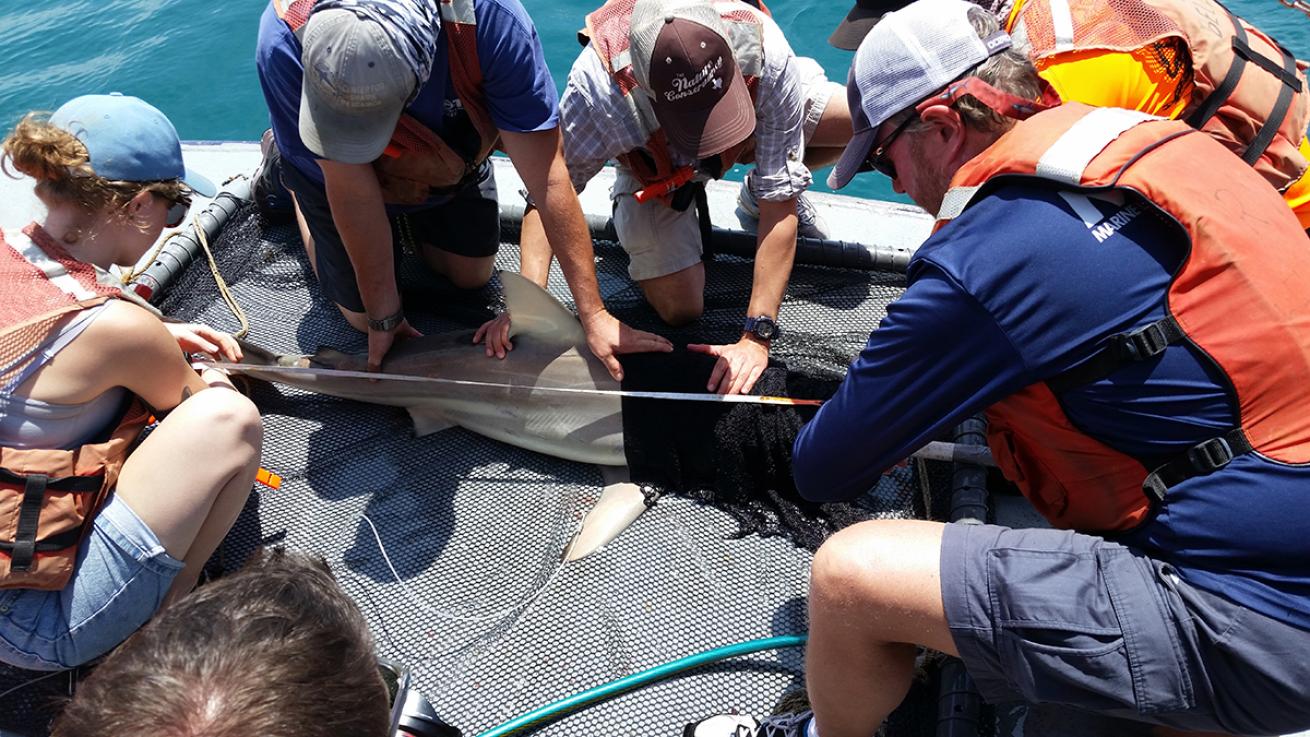What it’s Like to Tag a Shark

Melissa GaskillWhen a shark is raised from the water for tagging, additional information like length is gathered at the same time to aid in scientific analysis.
I’m peering off the back of the R/V Bellows, the Florida Institute of Oceanography’s research ship, standing with a team of scientists from the Institute and Mote’s Center for Shark Research. We’re fishing for sharks in clear, calm Gulf of Mexico waters about five miles off the west coast of Florida.
Earlier, the team baited dozens of hooks that hung along a heavy line spooling out nearly a mile. The boat then circled back to see what we caught. That’s when we see it — our first shark on a line.
Everyone springs into action. Using a large, flat net, we net hoist it onto the open deck. It’s a female bull shark. Someone pokes a modified hose into the shark’s toothy mouth to keep water running over her gills while several others gently hold the shark. More people still measure her and collect a blood sample. One researcher injects a dart tag – a small, numbered piece of plastic hanging on a thin line – near the dorsal fin. Another attaches a satellite tag the size of an old flip phone to the fin itself. Here to observe and learn, I dodge all this action along with piles of buoys, boxes of tools, and barrels of water and bait.
I’m a huge fan of seeing sharks on dives and find being (safely) this close to them fascinating. During the expedition, I learn the importance of studying shark numbers and movements and the role tagging plays, with a growing admiration for the people doing this gritty, physical fieldwork.
Mote’s Center for Shark Research has put dart tags on thousands of sharks during more than 30 years of research. Over my two days with the team, we tag 22. These tags are inexpensive and easy to apply, and when someone catches a previously tagged shark, it gives researchers an idea how far the animal traveled in the interim. Satellite tags cost significantly more, but transmit frequent locations that reveal the path of a shark’s movement. Tagged white sharks routinely migrate 6,000 miles in a season. A whale shark tagged off Mexico’s Yucatan peninsula swam through the Caribbean and out to the middle of the Atlantic Ocean. By revealing where sharks hang out and routes they travel, tagging and tracking helps us figure out how best to protect them. About a quarter of the world’s 500 or so shark species are considered vulnerable or threatened; some shark populations have declined as much as 90 percent.
I later learn that a young tiger shark we tagged on this trip went on to travel nearly 1,000 miles in less than two months. Our bull shark headed about 150 miles south, came back to this same general area, then swam north and hung out between Apalachee Bay and Tampa.
I kneel beside the bull shark and run my hand along her sleek body, head to tail. It feels as smooth as wet sand. I move my hand in the opposite direction, but quickly jerk it away. Sharks have thousands of tooth-like structures called denticles embedded into their skin. Rubbed the wrong way, the denticles are rougher than sandpaper. In the right direction, though, they create an extremely slick, hydrodynamic surface, giving sharks impressive swimming abilities. As we ease the now-tagged shark back into the water, she puts that ability to use, quickly disappearing into the blue.










